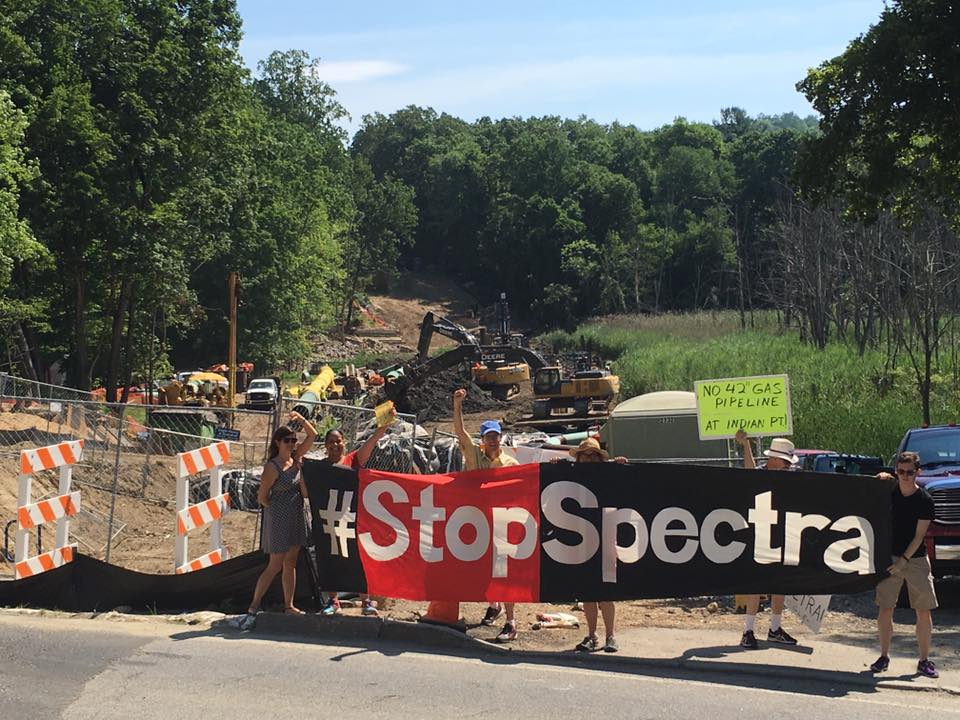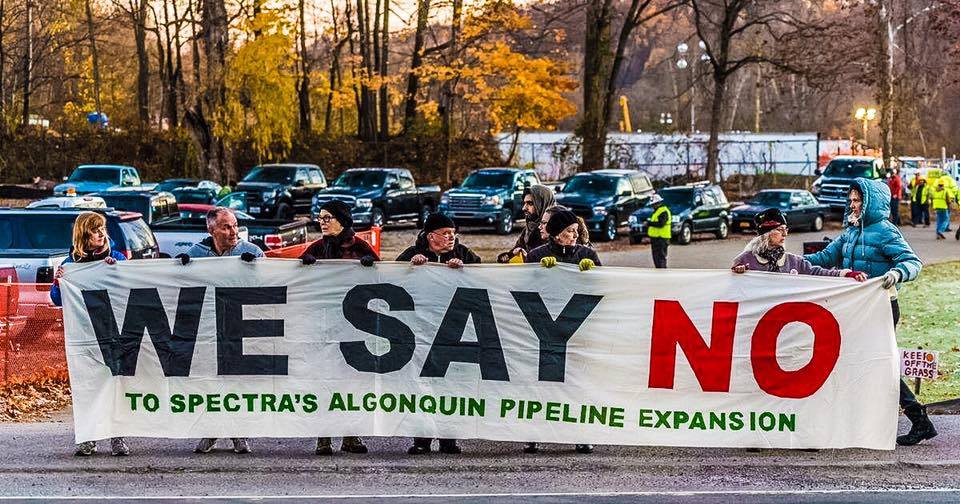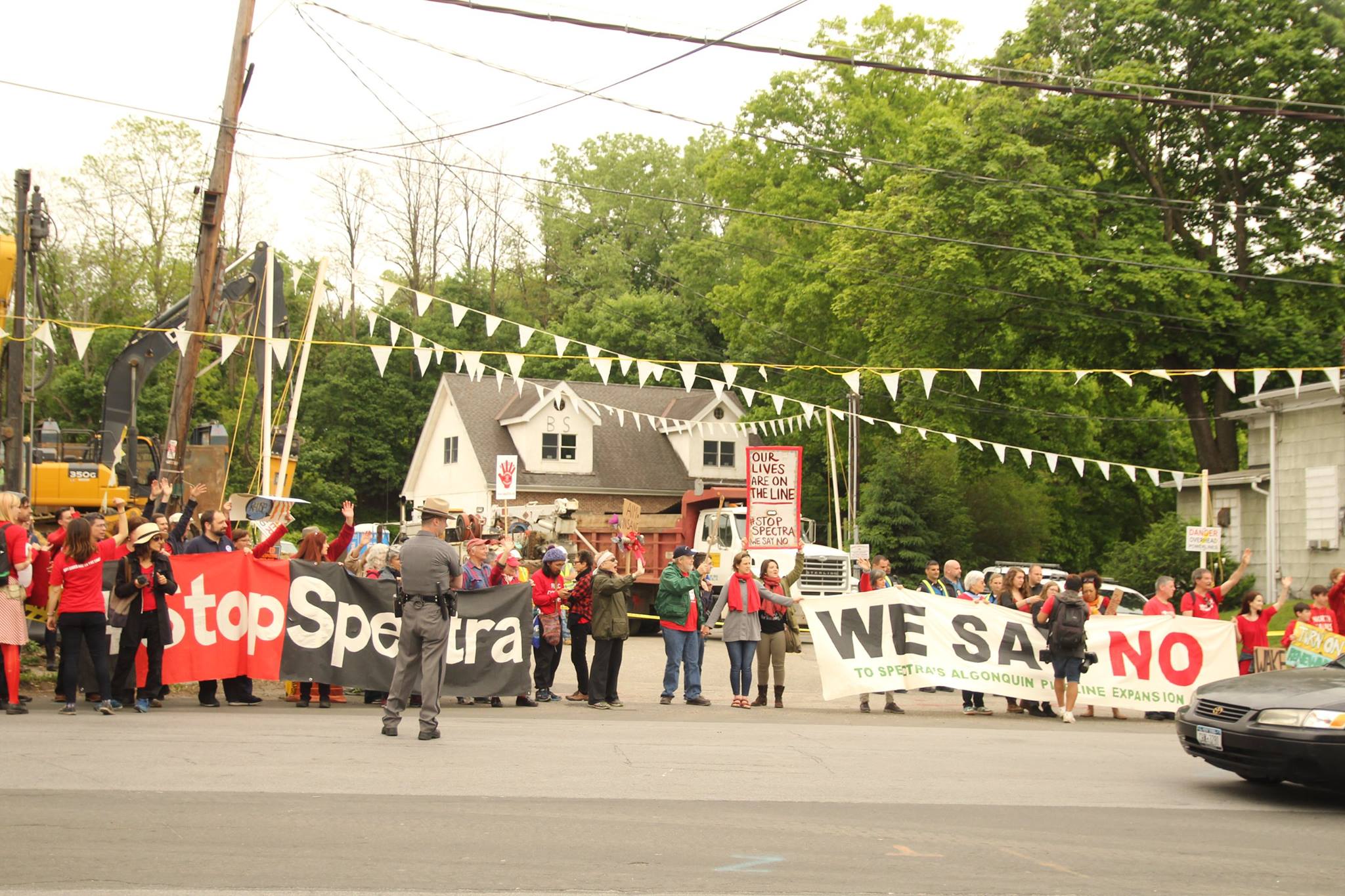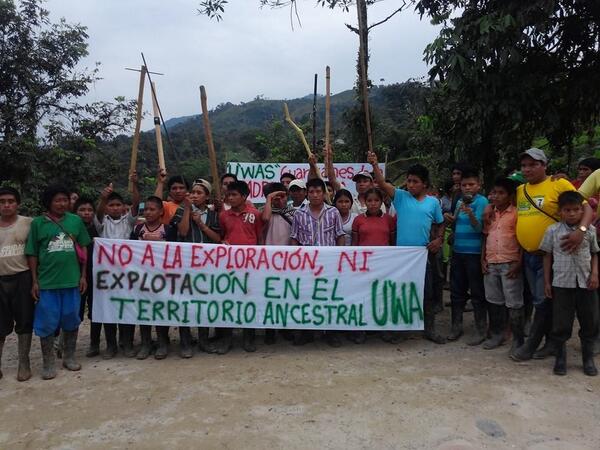
by Deep Green Resistance News Service | Aug 30, 2016 | Obstruction & Occupation
By ResistAIM
Brooklyn, NY – Concerned New Yorkers blocked the doors of National Grid’s downtown Brooklyn office at noon on Monday, August 29 to protest their support of Spectra Energy’s AIM Pipeline, a -brooklyn-demanding-national-grid-stop-support-spectra-energys-dangerous-aim-pipelinehigh-pressure methane gas pipeline that will bring fracked gas from Pennsylvania to New England. Members of 350Brooklyn.org, 350NYC.org, and ResistAIM came together to demand that National Grid end their contract agreement with Spectra Energy. The pipeline’s route runs 105 feet from infrastructure critical to the Indian Point Nuclear Power Plant in New York’s Westchester County. “National Grid is risking the safety of the 17 million people who live within 50 miles of the aging Indian Point reactor so it can sell gas in other parts of the country and the world,” says Mimi Bluestone of 350Brooklyn, one of eight people arrested as part of the day’s action. “Our governor and our US senators have called on the federal government to withdraw its authorization for this pipeline. But without National Grid’s end-of-pipeline agreement to buy this gas, the project could not be economically viable.”
Both elected officials and local residents have repeatedly raised concerns about the pipeline’s safety. This past February, Governor Andrew Cuomo asked the pipeline’s builder, Spectra Energy Corp of Texas, to suspend the project pending an independent safety analysis. “The safety of New Yorkers is the first responsibility of state government,” Cuomo said in making the request. In May, New York Senators Chuck Schumer and Kirsten Gillibrand asked the Federal Energy Regulatory Commission, which has jurisdiction over the pipeline, to halt construction pending such a study. Spectra Energy and FERC have denied the governor’s and the senators’ requests.
The AIM (Algonquin Incremental Market) pipeline is designed solely to deliver natural gas to New England; New York is simply a “pass through” state. The pipeline will enter New York in Rockland County, pass under the Hudson River, and then cross Westchester County en route to Connecticut. Built in the 1970s, Indian Point Nuclear Power complex remains active and contains decades of spent radioactive nuclear fuel, while over 17 million people live within 50 miles of Indian Point. National Grid, a British multinational, expanded into the United States beginning in 2000 by buying a number of local utilities in New England and New York, including the successor to Brooklyn Union Gas. It is a major potential customer for the natural gas that the AIM pipeline would transport to New England and so has the power to determine the financial viability of this project. Last week, National Grid withdrew its petition for a 20-year contract on Spectra’s Access Northeast project; however, National Grid is still expected to purchase gas flowing through the AIM Pipeline and so activists in Rhode Island, Massachusetts and New York are continuing to call on National Grid to cancel the contract.
The AIM pipeline is scheduled to be completed in November 2016, which calls for immediate action. On Monday evening, following the arrests at National Grid, concerned New Yorkers are gathering at the Brooklyn home of Senator Charles Schumer to encourage him to stand with New Yorkers by making a public appearance to denounce the pipeline and calling for a Government Accountability Office (GAO) investigation of the Federal Energy Regulatory Commission – more details can be found HERE.
350.org is a national organization working to keep carbon in the ground and to build a new, more equitable low-carbon economy. Its affiliates like 350NYC and 350Brooklyn work on local issues related to climate change. ResistAIM is a coalition of environmental advocates, Westchester residents and concerned New Yorkers that have been taking nonviolent direct action to stop the AIM Pipeline since November 2015.
A map of the AIM pipeline’s route: http://www.spectraenergy.com/Operations/US-Natural-Gas-Operations/New-Projects-US/Algonquin-Incremental-Market-AIM-Project/
A map of the pipeline’s proximity to the Indian Point Nuclear Power Plant: https://sape2016.org/2015/07/16/nuclear-regulatory-commission-withheld-and-misrepresented-critical-information-used-to-evaluate-and-approve-the-siting-of-the-spectra-aim-pipeline-alongside-indian-point/
For Cuomo’s position: http://www.bloomberg.com/news/articles/2016-02-29/cuomo-seeks-halt-of-spectra-algonquin-gas-line-for-safety-review
For Senator Gillibrand and Schumer’s position: https://www.gillibrand.senate.gov/newsroom/press/release/schumer-gillibrand-urge-ferc-to-suspend-construction-on-aim-pipeline-expansion-until-independent-health-and-safety-studies-are-conducted
For 350NYC: https://350nyc.org/
For 350Brooklyn: http://350brooklyn.org/
For ResistAIM: www.resistaim.com

by Deep Green Resistance News Service | Aug 3, 2016 | Lobbying
By ResistAIM
On Friday, July 29th, a coalition of 21 plaintiffs including local groups Riverkeeper, Sierra Club Lower Hudson, Food & Water Watch NY, Stop the Algonquin Pipeline Expansion (SAPE), and Reynolds Hill, Inc. filed a brief in the U.S. Court of Appeals for the District of Columbia seeking to overturn the Federal Energy Regulatory Commission’s (FERC) March 2015 approval of Spectra Energy’s Algonquin Incremental Markets (AIM) pipeline project. Although many state and local officials, including Governor Andrew Cuomo, both New York Senators and Representatives Nita Lowey and Eliot Engle have come out against the pipeline, so far construction is still moving forward.
The coalition’s brief addresses some of the points they had raised in their Rehearing Request that FERC rejected in January 2016. First it argues that the Commission improperly segmented the Algonquin pipeline expansion by dividing it into three different projects to avoid having to address its full environmental impact. As one Spectra official told an industry journal “you end up with a lot less potential opposition if you do that.” The AIM project is the first of three expansion Spectra plans for the Algonquin pipeline. The other two, Atlantic Bridge and Access Northeast, continue precisely where Aim leaves off to create a greatly enlarged path for fracked gas from Pennsylvania to Canadian export terminals.
Approximately 2,159 feet of the AIM pipeline will run through property that is part of the Indian Point nuclear power plant. The brief challenges the approval of installing the pipeline a little over 100 feet from critical safety structures at the Indian Point. It notes that the Commission relied on findings by Entergy Nuclear Operations, the company that operates Indian Point, and the Nuclear Regulatory Commission (NRC), neither of which have expertise in pipeline safety. Entergy and the NRC had concluded that the AIM Project would not impact safety at Indian Point, a conclusion challenged by both elected officials and independent nuclear and pipeline safety experts.
Lastly the brief argues FERC violated its own regulations by relying on a third-party contractor that had a financial interest in the construction of the AIM Project. FERC relies on third-party contractors to prepare the Environmental Impact Statements required for approving projects. Those contractors are identified by and paid for by the project applicant – in this case Spectra. To avoid conflicts of interest, potential third-party contractors must complete and submit an Organizational Conflict of Interest statement. No such statement has been found in the AIM record however. An investigation has also revealed that NRG, the third-party contractor that prepared the Environmental Impact Statement for AIM, was working for Spectra on another related project at the same time in an apparent violation of FERC regulations.
Nancy Vann, whose property is being taken by eminent domain for the AIM project, said “FERC has only rejected one pipeline project in its entire 40 year history. It’s shameful that the public must take a government agency to court in order to make it do its job. I’m so grateful for the determination of Riverkeeper, SAPE, Food & Water Watch and all of the other coalition members who have persisted in asserting these important issues and I’m looking forward to getting our day in court.”

by Deep Green Resistance News Service | Jun 29, 2016 | Obstruction & Occupation
Nine community members arrested for blocking construction on Spectra Energy’s AIM pipeline expansion – known as the “Montrose 9″ – join the national debate over harms caused by fossil fuel infrastructure
By ResistAIM
Cortlandt, NY — The “Montrose 9” are nine community members arrested for disorderly conduct for allegedly blocking traffic near the access to a Spectra Energy construction yard used for the expansion of a high-pressure fracked-gas pipeline known as the AIM pipeline. Their trial has the potential to become a landmark case with national implications involving the “necessity defense.” Defense counsel Martin R. Stolar is a prominent social justice attorney who argues that the defendants’ actions were justified since they were undertaken to stop a greater harm and were carried out only after all other legal and regulatory options had been exhausted. Court adjourned until July 15th at 1pm, when the other seven defendants are expected to testify regarding their reasons for taking direct action against the project.
While the necessity defense has been used in other types of cases, it is unusual in environmental litigation. One case occurred in May 2013 in Massachusetts when a small lobster boat managed to blockade a barge containing 40,000 tons of coal near the Brayton Point Power Plant. The charges of obstruction were dismissed and the presiding judge stated that the actions were morally justified. In a recent Seattle case, the “Delta 5” were found guilty of trespass for blocking an oil train but not guilty of obstruction. Jurors in that case cited sympathy for the activists and feeling of gratitude for their personal sacrifice for the good of all.
In questioning the prosecution’s police witnesses, Mr. Stolar also suggested a more traditional reason to dismiss the charges. He established that the defendants were not, in fact, causing the traffic jam on Route 9A as was charged. Rather, the Spectra workers caused the tie up when they obstructed the roadway with their cars. Police testified that once they began directing the workers to move, the congestion began to clear up even before the arrests took place. When asked how he determined that the cars belonged to pipeline workers, one officer replied that “there were a lot of out of state license plates.”

The greater harm to be prevented:
Defense witnesses, Cortlandt Councilman Seth Freach and two nuclear experts, testified to the dangers posed by the AIM pipeline. Councilman Freach discussed his own, and the Town Board’s, concerns about public health and safety and described letters that were sent to the Federal Energy Regulatory Commission (FERC) and other regulatory agencies expressing those concerns. Among the materials Cortlandt submitted to FERC was a report from an independent study that the Town had commissioned. Councilman Freach noted that, based on the Board’s thorough evaluation of the project, members had voted unanimously in opposition to the pipeline.
Paul Blanch, an engineer with over 50 years of nuclear experience, stated that there were “very significant unaccounted for risks” with the AIM pipeline and “an unacceptable probability” of a serious or catastrophic accident due to the pipeline’s close proximity to the Indian Point nuclear power plant. He also provided details of his efforts opposing the pipeline at the Nuclear Regulatory Commission and the Department of Transportation’s (DOT) Pipeline and Hazardous Materials Safety Administration.
Physicist Paul Moskowitz described the radioactive materials, including lead 210 and polonium 210, that result from decay of the radon in fracked gas. He went on to discuss regulatory filings he’d submitted detailing his concerns about radioactive emissions from the AIM pipeline and their impacts on human health. He testified that FERC’s response to his concerns were “a total fabrication” that “ignored over 50 years of established science.” When asked about what process would be used to deal with these dangerous substances, he responded that since FERC denies the existence of those known radioactive materials in pipelines there is no process in place for dealing with them.
Two defendants explain their actions:
Only two of the Montrose 9 defendants were able to testify before court concluded for the day. Both told their own individual stories of why they had stepped up to protest in such a compelling way. Although members of the community have been working through regulatory channels, their efforts have been met with delays and legal maneuvers, leaving them no recourse but to pursue more direct actions.
Linda Snider testified that since all of the regulatory agencies had ignored the issues, she felt she needed to stop AIM construction herself. She stated, “I wanted to stop the Spectra trucks and stop them from putting in this pipeline. We’ve just got to stop this.”
Defendant Susan Rutman, a landscape photographer who lives next to the Hudson River, was the final witness for the day. She explained she had sought to stop the work through writing to officials. “My intention was to stop the pipeline, because I knew it would prevent a far greater harm.” she said.
Find out more information about the AIM Pipeline and ongoing resistance here:
Online: www.resistaim.wordpress.com
On Facebook: www.facebook.com/resistaim
On Twitter: https://twitter.com/ResistAIM

by DGR Colorado Plateau | Oct 21, 2015 | Indigenous Autonomy, Lobbying, Mining & Drilling
CASE ON INDIGENOUS LAND RIGHTS AND EXTRACTIVE PROJECTS MOVES FORWARD AT INTER-AMERICAN COMMISSION ON HUMAN RIGHTS
Washington, DC – The U’wa Nation has received an admissibility report by the Inter-American Commission on Human Rights allowing its case against Colombia to move forward, recognizing that the indigenous group can seek the Commission’s help in defending its traditional territory. Although the U’wa have successfully defeated multiple oil and gas projects in the nearly two decades since they first filed their complaint with the Commission, the report recognizes that winning these battles does not end the overall complaint with the Colombian government, which does not fully recognize the U’wa people’s rights to their territory.
In a statement released [on Oct. 16], The U’wa organization Asou’wa said: “Our U’wa Nation has been heard by the natural law, our ancestors and gods that guide and govern our thinking to safeguard, protect and care for our mother earth; While there are U’wa people, we will continue resisting in defense of our ancient rights.” EarthRights International (ERI) has been supporting Aura Tegria Cristancho, an U’wa lawyer who has been working on the case since 2013 from its offices in Lima, Peru, and Washington, DC.
Asou’wa, supported by the National Indigenous Organization of Colombia and the Coalition for Amazonian Peoples and Their Environment, first filed their complaint with the Commission in 1997. At the time, US-based Occidental Petroleum (Oxy) was threatening to drill for oil in their lands. The U’wa, supported by a global campaign against Oxy led by groups such as Amazon Watch and the Rainforest Action Network, secured Oxy’s withdrawal in 2001. More recently, Colombia’s Ecopetrol tried to move forward with a gas project on U’wa land, but pulled out earlier this year. However, U’wa’s title over their ancestral lands have not been yet recognized.
The Commission’s decision comes after the U’wa and their supporters made it clear that, despite these victories, the root of the problem is the government’s lack of recognition and protection of the indigenous group’s ancestral territory.
“With this decision, the Commission recognized that even though Oxy and Ecopetrol pulled out, the U’wa remain threatened by the failure to fully protect their homeland,” said Camila Mariño, a Colombian lawyer and legal fellow with EarthRights International. “We are proud to stand with the U’wa.”
In the decision, dated July 22 but only released [now], the Commission formally accepts the U’wa petition as “admissible.” According to the Commission’s website, only twelve cases have been accepted as admissible so far this year. Following this decision, the case will move to the “merits” stage, in which the Commission will rule on the rights violations at issue.
– 30 –
Contact:
Valentina Stackl
+1 (202) 466 5188 x 100
valentina@earthrights.org






